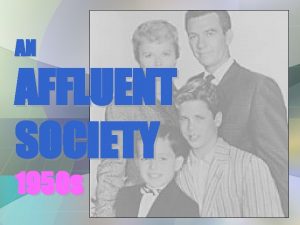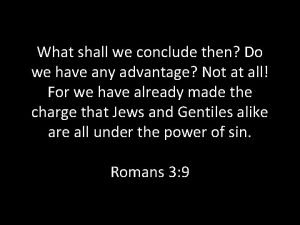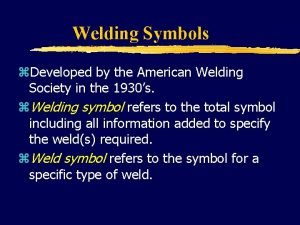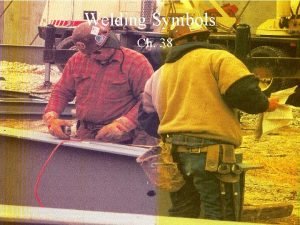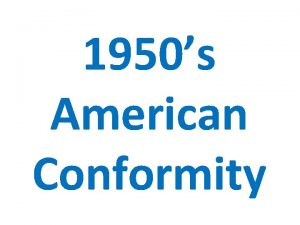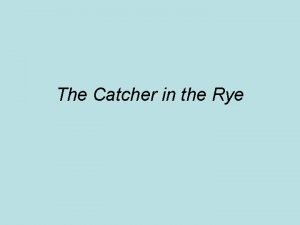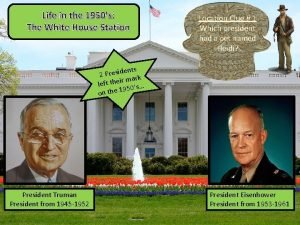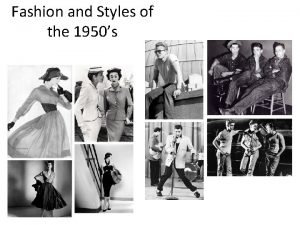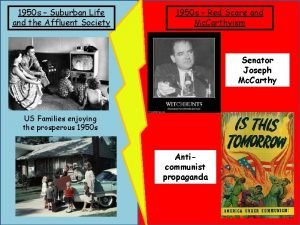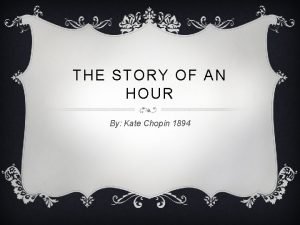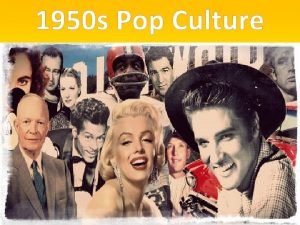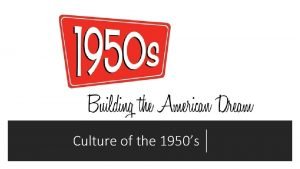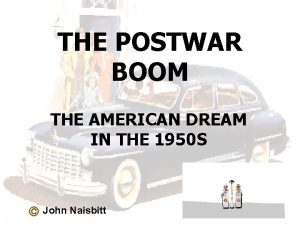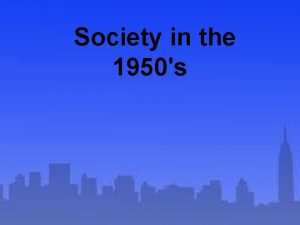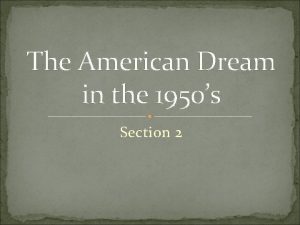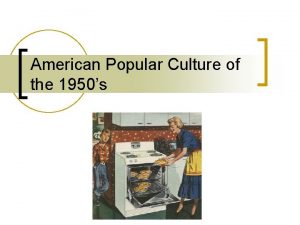American Society thru the 1950s A Returning to








































- Slides: 40

American Society thru the 1950’s

A. Returning to Peace Time

GI Bill • Servicemen’s Readjustment Act (1944) • Provided for – Education – Unemployment Compensation – Low Cost Home Loans – Low Cost Business Loans • Spurred the Growth of the Economy of the 1950’s

Move to the Sunbelt • Move continued after WWII • Air-conditioning & defense industries spurred movement

The Affluent Society • Economic Boom 1950 -1970 • National Income doubles each decade

B. Politics of the Era

Truman’s Fair Deal (1949) • Program of Social Improvement • Continuation of New Deal with: – Minimum Wage – Increased rights for African Americans – National Health Insur "Every segment of our population, and every individual, has a right to expect from his government a fair deal. " • Major success was the Housing Act of 1949 and minimum wage

nd 22 Amendment (1951) • Limited presidents to 2 terms or 10 years maximum • Conservative move because of 17 years of Democratic control

Election of 1952 • Truman decides not to run • Eisenhower wins • 1 st Republican president since the Depression

Dynamic Conservatism • Ike’s policy conserving money, while still providing for citizens – Increased Soc Sec & minimum Wage – Created the Dept of Health, Education & Welfare (1953) • Tried to balance the budget: – Reducing farm subsidies – Reducing defense spending

Alaska & Hawaii • Alaska becomes 49 th state • Hawaii becomes 50 th state

C. The Baby Boom

It seems to me that every other young housewife I see is pregnant. -- British visitor to America, 1958 • Increase in birth rate from 19461964 1957 1 baby born every 7 seconds

D. Suburban Living

Housing Shortage led to planned mass produced suburban communities Levittown, NY: “The American Dream” 1949 William Levitt produced 150 houses per week. $7, 990 or $58/month with $90 down payment.

The New “American Dream” • 1 story high • 12’x 19’ living room • 2 bedrooms • tiled bathroom • garage • small backyard • front lawn By 1960 1/3 of the U. S. population in the suburbs.

SHIFTS IN POPULATION DISTRIBUTION, 1940 -1970 Central Cities Suburbs Rural Areas/ Small Towns 1940 31. 6% 1950 1960 1970 32. 3% 32. 6% 32. 0% 19. 5% 23. 8% 30. 7% 41. 6% 48. 9% 43. 9% 36. 7% 26. 4%

• Strengthened the idea of the nuclear family as the model for American life

E. Consumerism

• Money saved in WWII was ready to be spent • More disposable income increased spending All babies were potential consumers who spearheaded a brand-new market for food, clothing, and shelter. -- Life Magazine (May, 1958)

• Americans were buying new products that would modernize their lives • Planned Obsolescence – goods would wear out

F. A Changing Workplace

Taft-Hartley Act (1947) • Response to the strikes of 1946 – 5 million workers went on strike • Gave government more control over unions – 60 day wait period – Outlawed closed shops – States could regulate union shops

AFL-CIO Merger (1955) • 2 largest labor unions joined in 1955 • Will run into problems because of Jimmy Hoffa & the Teamsters

Landrum-Griffin Act (1959) • Ike’s response to Jimmy Hoffa & the Teamsters • Tightened government control over unions • ALL unions suffered because of this and membership declines

Further Changes Automation of Industries : 1947 -1957 factory workers decreased by 4. 3%, eliminating 1. 5 million blue-collar jobs. By 1956 more white-collar than blue-collar jobs in the U. S. Computers Mark I (1944). First IBM mainframe computer (1951).

G. Culture of the Car

Became the center of the new lifestyle of the 1950’s 1958 Pink Cadillac Car registrations: 1959 Chevy Corvette 1945 25, 000 1960 60, 000 2 -family cars doubles from 1951 -1958

The Drive-In Culture America became a more uniform nation with franchise businesses because of the automobile. First Mc. Donald’s (1955) Drive-In Movies Howard Johnson’s

H. The Television

The Rise of T. V. 1946 1950 7, 000 TV sets in the U. S. 50, 000 TV sets in the U. S. 1960 one set 9 out of 10 families owned at least Reached a Mass Audience TV celebrated traditional American values. Truth, Justice, and the American way!

Television - Family Shows Glossy view of mostly middle-class suburban life. The Donna Reed Show 1958 -1966 Leave It to Beaver 1957 -1963 Father Knows Best 1954 -1958 The Ozzie & Harriet Show 1952 -1966

I. Teen Culture •

Who is a Teenager? In the 1950 s the word “teenager” entered the American language. Person between 13 -19 who had their own unique fads and fashions separate from the adult world that will be targeted by advertisers

Behavioral Rules of the 1950 s: CONFORMITY U Obey Authority. U Control Your Emotions. U Don’t Make Waves Fit in with the Group. U Don’t Even Think About Sex!!! 1951 → “Race” Music: Rhythm & Blues → Rock ‘N Roll

Rock ‘n Roll • Believed to make teenagers behave inappropriately Jerry Lee Lewis Buddy Holly

Delinquency “Juvenile Delinquency” 1951 J. D. Salinger’s A Catcher in the Rye Marlon Brando in The Wild One (1953) James Dean in Rebel Without a Cause (1955)

The Non-Conformists The “Beat” Generation: f Jack Kerouac (On The Road) and other writers f Wrote about not conforming to societies mores f Found a strong following in teenagers “Beatnik” “Clean” Teen

J. Gender Roles

The Cult of Domesticity Returns The ideal modern woman married, cooked and cared for her family, and kept herself busy by joining the local and leading a troop of Campfire Girls. She entertained guests family’s suburban house and worked out on the trampoline to her size 12 figure. -- Life magazine, 1956 The ideal 1950 s manwas the provider, protector, and the boss of the house. -- Life magazine, 1955 'The women’s place was in the home, the man was the breadwinner. 'In reality, to support the middle class lifestyle, more women are going to enter the workforce. 'By 1960 40% of women are working full or part time
 The affluent society 1950s
The affluent society 1950s Huntsvillecs.powerschool.com
Huntsvillecs.powerschool.com A value-returning function is
A value-returning function is Leaving returning
Leaving returning Ut tyler scholarship
Ut tyler scholarship I conclude then returning to being feared
I conclude then returning to being feared Returning back to god
Returning back to god Returning warrior workshop
Returning warrior workshop Land in the morning
Land in the morning Thru hole symbol
Thru hole symbol Gsa fleet drive thru
Gsa fleet drive thru Projection welding symbol
Projection welding symbol Welding shop drawings
Welding shop drawings Gsa drivethru
Gsa drivethru Gsa fleet card driver id
Gsa fleet card driver id Gsa fleet card
Gsa fleet card Gsa vehicle leasing guide
Gsa vehicle leasing guide How to make a hole in autocad
How to make a hole in autocad Halligan probar
Halligan probar Red scare 1950s
Red scare 1950s School punishments in the 1950s
School punishments in the 1950s Challenges to conformity in the 1950s
Challenges to conformity in the 1950s Trends of 1950s
Trends of 1950s Catcher in the rye background
Catcher in the rye background White house 1950s
White house 1950s 1950s fashin
1950s fashin Wwii show
Wwii show Suburban life 1950s
Suburban life 1950s Trends of 1950s
Trends of 1950s Pop culture of the 1950s
Pop culture of the 1950s Beat writers 1950s
Beat writers 1950s Concept cars of the 1950s
Concept cars of the 1950s Trends of 1950s
Trends of 1950s 1950s conformity and counterculture
1950s conformity and counterculture Why does richards rush to tell mrs. mallard the news
Why does richards rush to tell mrs. mallard the news Trends of 1950s
Trends of 1950s 1950s beatnik fashion
1950s beatnik fashion 1950's music trivia questions and answers
1950's music trivia questions and answers Trends of 1950s
Trends of 1950s 1950s mass media
1950s mass media Conglomerates and franchises 1950s
Conglomerates and franchises 1950s
